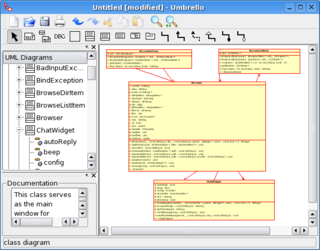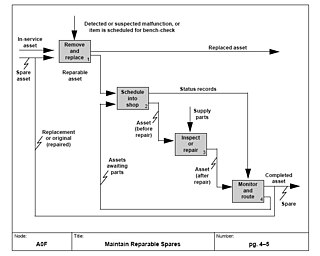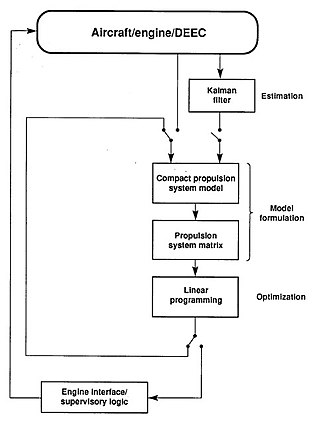In computer science, formal methods are mathematically rigorous techniques for the specification, development, analysis, and verification of software and hardware systems. The use of formal methods for software and hardware design is motivated by the expectation that, as in other engineering disciplines, performing appropriate mathematical analysis can contribute to the reliability and robustness of a design.
The rational unified process (RUP) is an iterative software development process framework created by the Rational Software Corporation, a division of IBM since 2003. RUP is not a single concrete prescriptive process, but rather an adaptable process framework, intended to be tailored by the development organizations and software project teams that will select the elements of the process that are appropriate for their needs. RUP is a specific implementation of the Unified Process.
Software development is the process used to conceive, specify, design, program, document, test, and bug fix in order to create and maintain applications, frameworks, or other software components. Software development involves writing and maintaining the source code, but in a broader sense, it includes all processes from the conception of the desired software through the final manifestation, typically in a planned and structured process often overlapping with software engineering. Software development also includes research, new development, prototyping, modification, reuse, re-engineering, maintenance, or any other activities that result in software products.
A modeling language is any artificial language that can be used to express data, information or knowledge or systems in a structure that is defined by a consistent set of rules. The rules are used for interpretation of the meaning of components in the structure Programing language.

IDEF, initially an abbreviation of ICAM Definition and renamed in 1999 as Integration Definition, is a family of modeling languages in the field of systems and software engineering. They cover a wide range of uses from functional modeling to data, simulation, object-oriented analysis and design, and knowledge acquisition. These definition languages were developed under funding from U.S. Air Force and, although still most commonly used by them and other military and United States Department of Defense (DoD) agencies, are in the public domain.

Computer-aided software engineering (CASE) was a domain of software tools used to design and implement applications. CASE tools were similar to and were partly inspired by computer-aided design (CAD) tools used for designing hardware products. CASE tools were intended to help develop high-quality, defect-free, and maintainable software. CASE software was often associated with methods for the development of information systems together with automated tools that could be used in the software development process.
Architecture description languages (ADLs) are used in several disciplines: system engineering, software engineering, and enterprise modelling and engineering.

IDEF0, a compound acronym, is a function modeling methodology for describing manufacturing functions, which offers a functional modeling language for the analysis, development, reengineering and integration of information systems, business processes or software engineering analysis.

Integration DEFinition for information modeling (IDEF1X) is a data modeling language for the development of semantic data models. IDEF1X is used to produce a graphical information model which represents the structure and semantics of information within an environment or system.
In software engineering, domain analysis, or product line analysis, is the process of analyzing related software systems in a domain to find their common and variable parts. It is a model of wider business context for the system. The term was coined in the early 1980s by James Neighbors. Domain analysis is the first phase of domain engineering. It is a key method for realizing systematic software reuse.
Domain engineering, is the entire process of reusing domain knowledge in the production of new software systems. It is a key concept in systematic software reuse and product line engineering. A key idea in systematic software reuse is the domain. Most organizations work in only a few domains. They repeatedly build similar systems within a given domain with variations to meet different customer needs. Rather than building each new system variant from scratch, significant savings may be achieved by reusing portions of previous systems in the domain to build new ones.
Executable UML is both a software development method and a highly abstract software language. It was described for the first time in 2002 in the book "Executable UML: A Foundation for Model-Driven Architecture". The language "combines a subset of the UML graphical notation with executable semantics and timing rules." The Executable UML method is the successor to the Shlaer–Mellor method.
In computer programming, feature-oriented programming (FOP) or feature-oriented software development (FOSD) is a programming paradigm for program generation in software product lines (SPLs) and for incremental development of programs.

In systems engineering, software engineering, and computer science, a function model or functional model is a structured representation of the functions within the modeled system or subject area.

A control-flow diagram (CFD) is a diagram to describe the control flow of a business process, process or review.
Feature oriented domain analysis (FODA) is a domain analysis method which introduced feature modelling to domain engineering. FODA was developed in 1990 following several U.S. Government research projects. Its concepts have been regarded as critically advancing software engineering and software reuse.

Xilinx ISE is a discontinued software tool from Xilinx for synthesis and analysis of HDL designs, which primarily targets development of embedded firmware for Xilinx FPGA and CPLD integrated circuit (IC) product families. It was succeeded by Xilinx Vivado. Use of the last released edition from October 2013 continues for in-system programming of legacy hardware designs containing older FPGAs and CPLDs otherwise orphaned by the replacement design tool, Vivado Design Suite.
Knowledge-based configuration, also referred to as product configuration or product customization, is an activity of customising a product to meet the needs of a particular customer. The product in question may consist of mechanical parts, services, and software. Knowledge-based configuration is a major application area for artificial intelligence (AI), and it is based on modelling of the configurations in a manner that allows the utilisation of AI techniques for searching for a valid configuration to meet the needs of a particular customer.
Metamorphic testing (MT) is a property-based software testing technique, which can be an effective approach for addressing the test oracle problem and test case generation problem. The test oracle problem is the difficulty of determining the expected outcomes of selected test cases or to determine whether the actual outputs agree with the expected outcomes.
Software Product Lines Online Tools (S.P.L.O.T.) is a set of research-oriented online tools for Software Product Lines (SPL) practitioners. S.P.L.O.T. was created by Marcilio Mendonca during his Ph.D. at the University of Waterloo, Canada, in 2008–2009. Since then, the academic website has been visited by numerous researchers and research groups worldwide thereby helping to advance the Software Product Lines field. S.P.L.O.T's source code are freely available on GitHub and have been successfully extended by others to address different research needs.
























